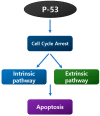Function and Application of Flavonoids in the Breast Cancer
- PMID: 35887080
- PMCID: PMC9323071
- DOI: 10.3390/ijms23147732
Function and Application of Flavonoids in the Breast Cancer
Abstract
Breast cancer is one of the top causes of death, particularly among women, and it affects many women. Cancer can also be caused by various factors, including acquiring genetic alteration. Doctors use radiation to detect and treat breast cancer. As a result, breast cancer becomes radiation-resistant, necessitating a new strategy for its treatment. The approach discovered by the researchers is a flavonoid, which is being researched to see if it might help treat radiation-resistant breast cancer more safely than an approved medicine already being used in the field. As a result, this study focuses on the role of flavonoids in breast cancer suppression, breast cancer gene anomalies, and the resulting apoptotic mechanism.
Keywords: apoptosis; breast cancer; flavonoid.
Conflict of interest statement
The authors clearly declare that they have no conflict of interest in this study.
Figures






References
-
- Yuan C., Chen G., Jing C., Liu M., Liang B., Gong G., Yu M. Eriocitrin, a dietary flavonoid suppressed cell proliferation, induced apoptosis through modulation of JAK2/STAT3 and JNK/p38 MAPKs signaling pathway in MCF-7 cells. J. Biochem. Mol. Toxicol. 2021;36:e22943. doi: 10.1002/jbt.22943. - DOI - PubMed
Publication types
MeSH terms
Substances
LinkOut - more resources
Full Text Sources
Medical
Research Materials

